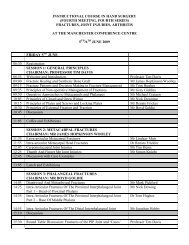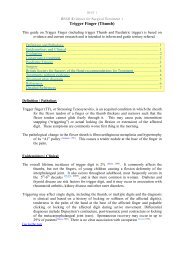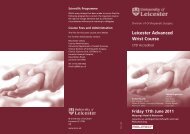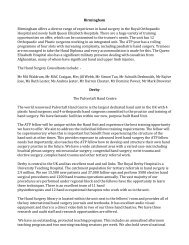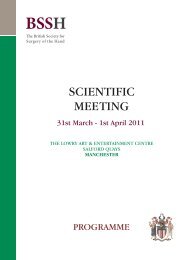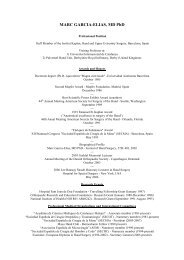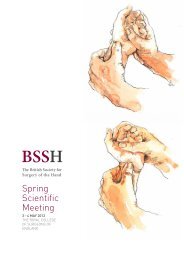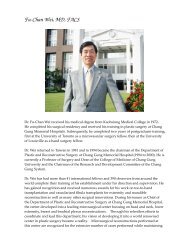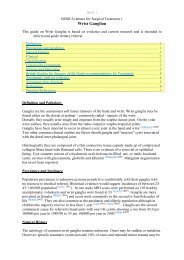here - The British Society for Surgery of the Hand
here - The British Society for Surgery of the Hand
here - The British Society for Surgery of the Hand
You also want an ePaper? Increase the reach of your titles
YUMPU automatically turns print PDFs into web optimized ePapers that Google loves.
POSTERS<br />
8 An Audit <strong>of</strong> Time to <strong>The</strong>atre <strong>for</strong> Open <strong>Hand</strong> Injuries in a Tertiary Referral Centre<br />
Dr M Tan, Miss R Dale, Miss K Owers (London)<br />
Introduction: <strong>Hand</strong> trauma is common and 20% <strong>of</strong> cases presenting to <strong>the</strong> Emergency Department require<br />
surgery. Risks <strong>of</strong> delayed surgery include infection and delay to rehabilitation with subsequent loss <strong>of</strong> function.<br />
Following recently published BSSH guidelines, our <strong>Hand</strong> Unit aims to treat all open hand injuries within 48<br />
hours <strong>of</strong> injury and badly contaminated wounds including open joints/fractures within 12 hours. We per<strong>for</strong>med<br />
an audit to establish if we were meeting our targets.<br />
Method: Data from all referrals accepted to <strong>the</strong> <strong>Hand</strong> Unit was prospectively collected over one month. Details<br />
recorded included time and mechanism <strong>of</strong> injury. <strong>The</strong>atre logbooks were used to ascertain <strong>the</strong> time <strong>of</strong> surgery<br />
and any reasons <strong>for</strong> delay. Patients with insufficient data to calculate waiting times and those presenting over 48<br />
hours post-injury were excluded.<br />
Results: 71/89 patients accepted by <strong>the</strong> <strong>Hand</strong> Unit met <strong>the</strong> criteria <strong>for</strong> inclusion. 22/71 were children and 100%<br />
had surgery within 48 hours. 23/49 (46.9 %) <strong>of</strong> adult patients had surgery within 48 hours. Of those requiring<br />
urgent surgical intervention, only 33.3% received it within 12 hours. Reasons <strong>for</strong> delay included lack <strong>of</strong> <strong>the</strong>atre<br />
space (26.1%), allocation to semi-elective day surgery slots over 48 hours post-injury (56.5%), and delay in<br />
presentation/referral (8.7%).<br />
Conclusion: <strong>The</strong> <strong>Hand</strong> Unit is currently not meeting its aims. We suggest <strong>the</strong> service could be improved by<br />
provision <strong>of</strong> dedicated hand surgery emergency lists and education <strong>of</strong> on-call doctors and referring hospitals<br />
regarding BSSH guidelines. We discuss methods <strong>of</strong> implementing <strong>the</strong>se suggestions and propose to re-audit in<br />
six months.<br />
9 An Audit <strong>of</strong> Flexor Tendon Injuries<br />
Miss N Breitenfeldt, Mr V Moonesamy, Mr A Watts (Exeter)<br />
Introduction: Flexor tendon injuries <strong>of</strong> <strong>the</strong> hand are common. Rupture rates following repair are reported in <strong>the</strong><br />
literature as 3-9% <strong>for</strong> finger/wrist flexors and 3-17% <strong>for</strong> FPL injuries. We per<strong>for</strong>med an audit <strong>of</strong> process and<br />
outcome to determine <strong>the</strong> rupture rate in our department and to identify any associated factors.<br />
Method: A retrospective analysis <strong>of</strong> hospital records, identified from our computerised operation logbook and<br />
physio<strong>the</strong>rapy database. All patients undergoing primary repair <strong>of</strong> a thumb, finger or wrist flexor tendon in our<br />
department during 2006 were included. <strong>The</strong> data collected included patient age, hand dominance, occupation,<br />
<strong>the</strong> zone and mechanism <strong>of</strong> injury, delay to repair, operative technique and follow-up, including <strong>the</strong> nature and<br />
compliance with hand <strong>the</strong>rapy.<br />
Results: Seventy patients were identified with 113 flexor tendon injuries. Of <strong>the</strong>se, six patients were known to<br />
have had an acute rupture following primary repair, all involving finger flexors (8.6% <strong>of</strong> patients, 5.3% <strong>of</strong><br />
tendons). Factors associated with acute rupture were injury to <strong>the</strong> dominant hand, zone and mechanism <strong>of</strong> injury<br />
and lack <strong>of</strong> compliance with post-operative hand <strong>the</strong>rapy.<br />
Conclusions: <strong>The</strong> rupture rate following flexor tendon repair in our department is similar to rates reported in <strong>the</strong><br />
literature. However, documentation was poor and needs to be improved. Rupture rate following flexor tendon<br />
repair could be used nationally as a comparative interdepartmental outcome measure. However, in order to be<br />
meaningful, fur<strong>the</strong>r work is needed to assess <strong>the</strong> factors associated with poor outcome and to identify potential<br />
mechanisms <strong>for</strong> improvement.<br />
10 Transient Nail Growth Arrest Due to Nerve Injury<br />
Mr K Deogaonkar, Mr J Elliott (Belfast)<br />
Injury to a particular nerve leads to transient growth disturbance <strong>of</strong> <strong>the</strong> nails in <strong>the</strong> dermatomes supplied by <strong>the</strong><br />
nerve.<br />
A young lady fractured her ulna and injured <strong>the</strong> ulnar nerve (neurapraxia) whilst playing Camogie, a Celtic team<br />
sport. <strong>The</strong> fracture healed after internal fixation. However she developed transient growth arrest <strong>of</strong> <strong>the</strong> nails in<br />
<strong>the</strong> three ulnar digits. <strong>The</strong> worried patient eventually has full regrowth <strong>of</strong> <strong>the</strong> involved nails as her nerve injury<br />
recovered.<br />
21



